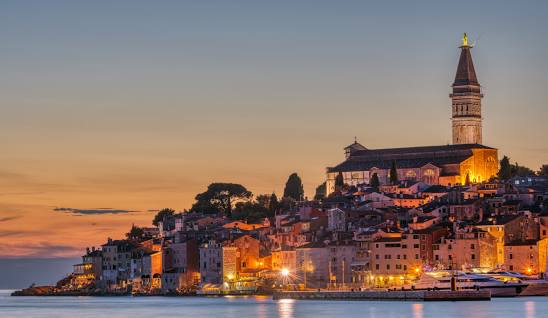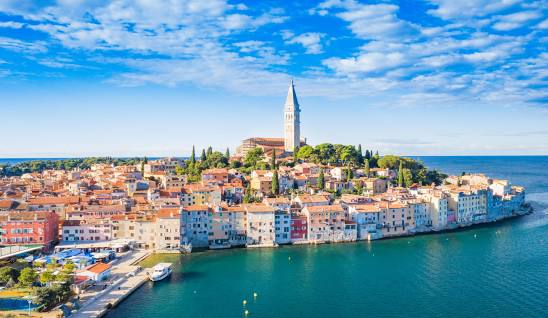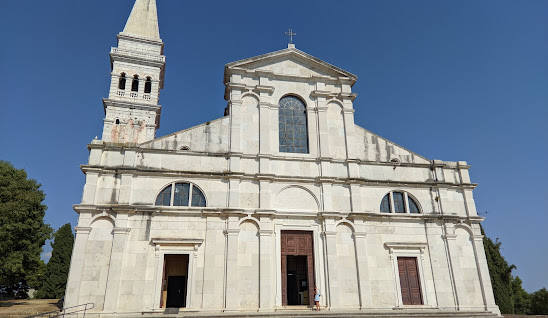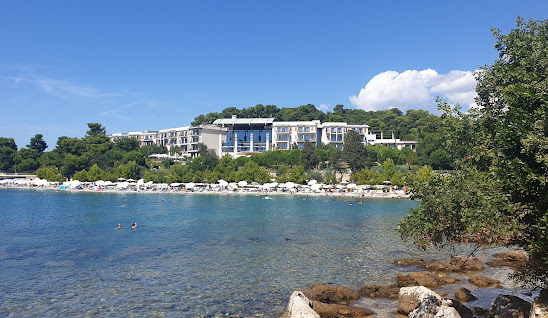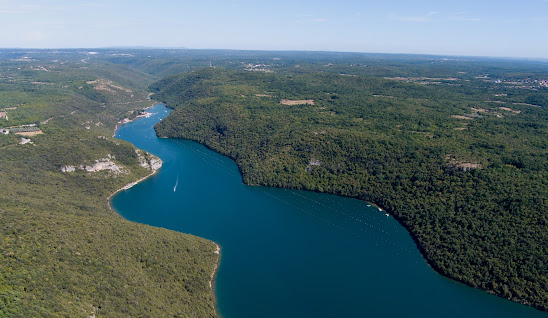The Preservation of Tradition and Cultural Heritage
Rovinj-Rovigno, Croatia – General Meeting
Sept 28 – Oct 1 (2023)

About our partner town, Rovinj-Rovigno
Rovinj-Rovigno is a charming coastal town located on the western coast of the Istrian peninsula in Croatia. It is known for its stunning architecture, picturesque streets, beautiful beaches, and rich cultural heritage.
Towards the end of 2023, we’re set to meet in Rovinj-Rovigno for our Douzelage General Meeting – where we will discuss the topic of this year: Historical and cultural heritage of our beautiful little towns, the way we preserve it, how we pass over the knowledge and thus the respect for it to the new generations and the new inhabitants of our towns (migrants and immigrants).
The Charming Town of Rovinj-Rovigno
History
Rovinj-Rovigno has a long and rich history, dating back to the Roman times. It was an important port and trading center during the medieval period, and later became a part of the Venetian Republic. The town has a strong venetian influence, evident in its architecture, culture, and cuisine.
Location
Rovinj-Rovigno is located on the Adriatic Sea, in the northwest of Croatia, close to the border with Italy. It is situated on a peninsula and is surrounded by the sea on three sides.
Architecture
Rovinj-Rovigno is renowned for its beautiful Venetian-style architecture, with colorful houses and narrow streets lined with shops, cafes, and restaurants. The most prominent landmark is the Church of St. Euphemia, which sits atop a hill overlooking the town.
Beaches
Rovinj-Rovigno has a number of beautiful beaches, both in the town and in the surrounding area. The most popular beaches are Monte Mulini, Lone Bay, and Cuvi Beach.
Culture
Rovinj-Rovigno has a rich cultural heritage, with a number of museums, art galleries, and cultural events throughout the year. The town is particularly famous for its summer music festival, which attracts musicians and music lovers from all over the world.
Food and drink
Rovinj-Rovigno is known for its delicious seafood and Italian-influenced cuisine. Some of the local specialties include Istrian ham, truffles, and homemade pasta. The town is also famous for its wine and olive oil, which are produced in the surrounding area.
Activities
There are plenty of activities to enjoy in Rovinj-Rovigno, including swimming, sunbathing, sailing, and kayaking. Visitors can also explore the town’s historic streets, take a boat trip to the nearby islands, or visit the nearby nature reserves.
The Preservation of Traditional and Cultural Heritage
Historical and cultural heritage is a valuable asset of any community, especially when it comes to small towns like our Douzealge partner towns. These towns are often rich in history and traditions that have been passed down through generations. Preserving this heritage is essential to maintaining a community’s identity and character, and passing it on to new inhabitants is crucial for ensuring its continuation.
Small towns are often overlooked when it comes to cultural heritage preservation, as the focus tends to be on larger cities and landmarks. However, these towns have their unique stories and traditions that are just as important to preserve. From traditional crafts and food to local festivals and celebrations, small towns have a wealth of cultural heritage that needs to be protected.
One of the primary ways to preserve cultural heritage is through education and awareness. New inhabitants need to understand the history and traditions of the town they are moving into, and the importance of preserving them. This can be achieved through community events, educational programs, and partnerships with local schools and universities.
Another way to preserve cultural heritage is through physical preservation. Historical landmarks, buildings, and monuments need to be maintained and protected to ensure their longevity. This can be done through regular maintenance, restoration, and conservation efforts. By protecting these physical elements, we can ensure that they continue to tell the story of the town and its people for generations to come.
In addition to preserving cultural heritage, it’s also important to promote it. Small towns can use their unique traditions and history to attract visitors and boost tourism. By showcasing the local culture, towns can draw in visitors who are interested in experiencing something new and authentic. This not only benefits the local economy but also raises awareness of the town’s cultural heritage.
It’s also essential to involve the community in cultural heritage preservation efforts. By creating a sense of ownership and pride in the town’s history and traditions, the community is more likely to take an active role in preserving them. This can be achieved through community events, volunteer opportunities, and partnerships with local businesses and organizations.
In conclusion, small towns have a rich cultural heritage that needs to be preserved and passed down to new inhabitants. Through education, physical preservation, promotion, and community involvement, we can ensure that this heritage continues to thrive. By preserving and promoting the cultural heritage of small towns, we can celebrate their unique history and traditions and ensure that they continue to be cherished for generations to come.
With all of this being said, can we expect to see you in Rovinj-Rovigno in September? You’ll be welcomed with open arms by our Douzelage Youth Family ♡

